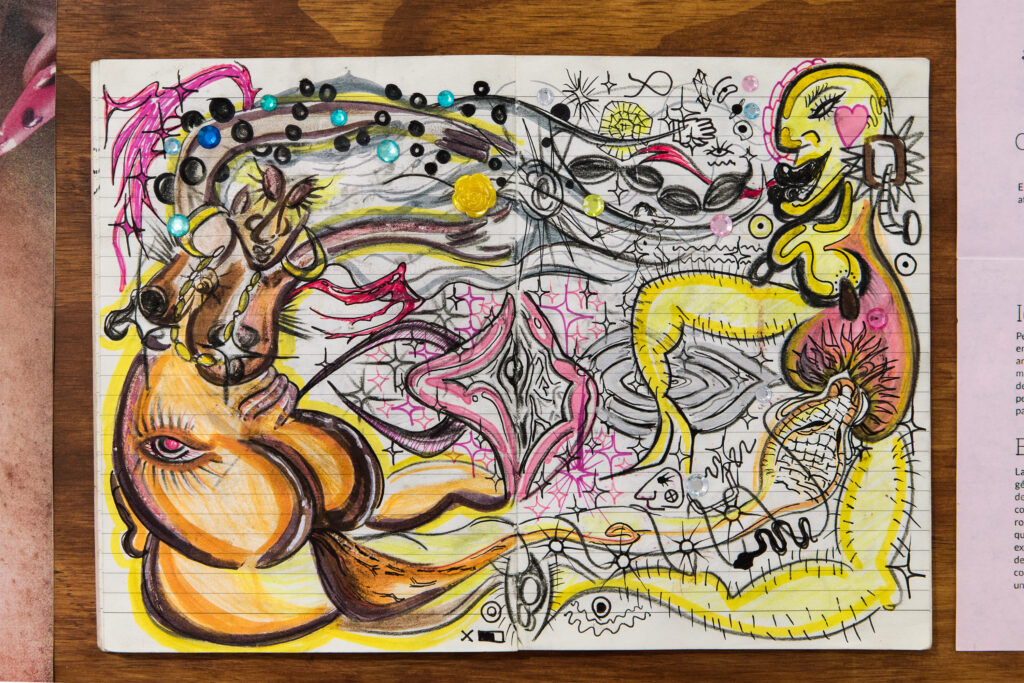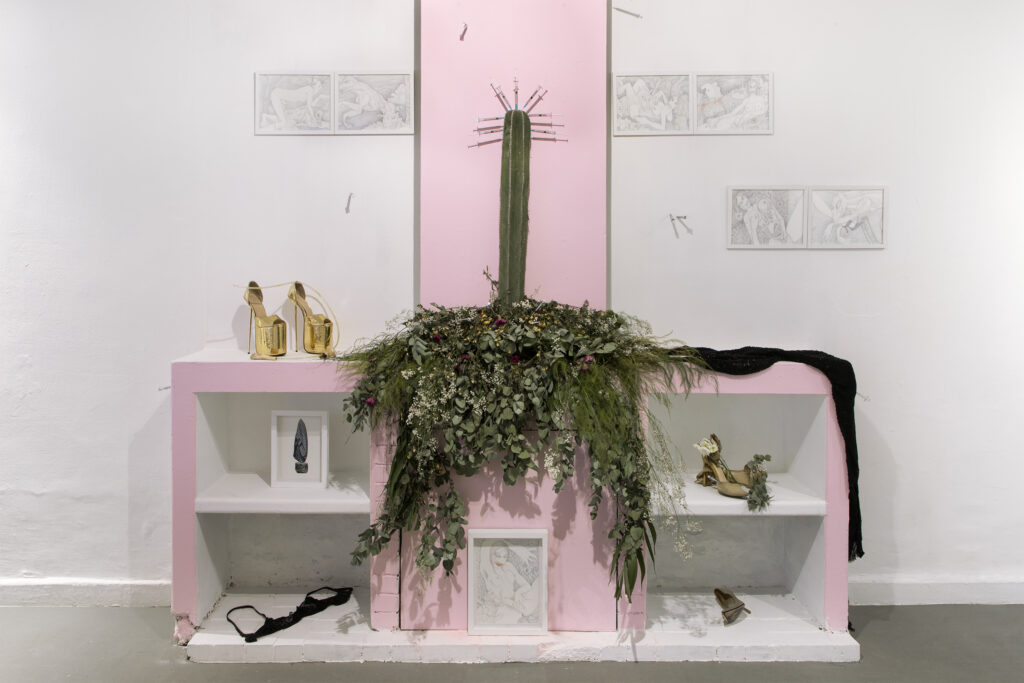Reviews - Archivo y Memoria Trans Ciudad de México - Mexico
Reading time: 7 minutes

28.11.2023
Aldri Covarrubias, curator of the Archivo de la Memoria Transmasculina MX, shares with us his reflection on “Embodied Plasticities: genealogical traces of the artistic production of trans women in Mexico (1970-2023)”, an exhibition curated by Rojo Génesis and hosted at Pandeo from September 22 to November 4.

In memory of Lupilla Xiu.
Rojo Genesis (Mexico, 1996) researches and curates Embodied Plasticities: genealogical traces of the artistic production of trans women in Mexico (1970-2023), the most complete and complex collaboration on art produced by trans women that closes the cycle of the more than ten years of existence of Pandeo, a multisocial space whose walls housed a transdisciplinary production and exchange of trans* lives in the Napoles neighborhood, in Mexico City, with the support of Bicefala. The exhibition is a retrospective that builds a memory not only of the oTrans before nosoTrans, but far beyond this. It focuses on a different genealogy, uniting works from the period between 1970 and 2023, where the discussion is not on one single theme, where there is no unifying technique and there is no surname or school of thought to govern them. They are not grandmothers, daughters or granddaughters of each other; what unites them is being creators, models who use modelers. What unites them is the pain and pleasure of the flesh, of living in contemporary and urbanized transfemininity in Mexico.
Free admission was a crucial issue so that visitors could review it more than once, and guided tours by the curator and artists were also included. Embodied Plasticities is not the first art exhibition made by trans women, nor does it want to be. It is enough to remember precedents such as Women on the verge of being sold, curated by Sofia Moreno in 2016 and recognized by the curator Rojo Genesis herself, who collected various cultural practices and representations of trans and non-conforming gender identities.
The relevance of these exhibitions lies precisely in the fact that they should no longer be exceptional, we need more of them. And it is important to point out that there is no merit in the first times and their stories when what we want is to
try another way of making and experiencing art.
Not all trans women who make art today are there, since space is limited; not only due to the conditions of assembling and production, but because Mexico continues to kill trans women and transfemininities with violence, without free public healthcare, and without means to survive. Far from continuing to reproduce practices and discourses of death, we point out the above because much of this archive is not in the hands of other trans women, but rather of people who have the economic and material conditions to preserve them.
In Embodied Plasticities, the first thing that stands out is the contrast with what is misleadingly called “contemporary LGBT+ art”, but which is exclusively produced by the corporalities of cis homosexual men. There is no such complacency here. This exhibition is relevant beyond identity: beyond being trans women just for being trans women. Its relevance lies in the social implication of what is stated here from an aesthetic point of view.
The body of work speaks for itself. In Sofia Moreno, we find an affront to the linearity of concepts such as nature-body through her experience as a migrant by means of drawing and sculpture. In Valis Ortiz, the use of science fiction and BDSM to create translesbian imaginaries full of power. In Viviana Rocco, iconoclasm and the promise of beauty in the abject. In Jovana, the magic of the dark body that doesn’t need any anti-racism on TikTok to defend it. In Lluvia, the escape from the absurd comparison between “high art” and “low art”, from what is hung on the walls and the creative avalanche between the floor and the ceiling. In Laura Glover, the alchemy of comic morbidity about trans women as a meme transmuted into the strength of the models who counterattack the shot of the camera and the visual regime with the power of their delinquent behavior. In Terry Holiday, the ancient ability to put on a show and remind the cisheteronorm how boring their existence is. In Poni Alta, the craft of making media and narratives through self-publishing and self-exploration. In Laura Victoria Martes, the grace and courage to transcend time without deception and with the responsibility of not giving up what we want when relating to ourselves through art. In Deborah Alvarez, the unexpectedness of being and doing art from the modelers to the canvas. In Naomi Torres, fury and flesh as the natural engine of life that does not ask for permission. In Romina Jauregui, the eternal commitment to oneself, that central promise of not abandoning yourself and being as big as your body. In Antia Alanis, the commemoration of creative possibilities by revealing to the world who one is openly, but also not sharing oneself with just anyone. In Rojo Genesis, the triumphant culmination of the idea that obesity shall see every mockery that threatens its existence crushed under its weight.

How to contain something that is overflowing? It is impossible, unless the objective is to retain, stop, oppress or follow the same logic from which what is overflowing escapes, taking away that je ne sais quoi that made it something worth treasuring in the first place.
We cannot isolate this exhibition in the current context in Mexico and the world, where the fascist offensive threatens everything that has no use for exploitation and the subjugation of everything that cannot be packaged, traded or made intangible to massify it.
This exhibition is exceptional in the most unfortunate sense of the word, since there should be more spaces and resources to carry them out.
This exhibition means more than what is seen in the works, around it occurs a sum without loss between people who create: the artists on display had a group conversation, workshops and sale of work that allowed them to be questioned in the first person and without intermediaries, something unusual in this country. The crossing between generations accounted for everything that has changed regarding the trans* issue over time, but also everything that has not changed: the doubts when creating, the lack of means for subsistence that make it impossible to do so, and the general contempt of the art world for those who do not belong to its elite.
The challenge of making what we understand by “trans art” more complex remains on the table. We must think beyond the superficiality and trappings of the gender identity of those who create it. We can put together a whole set of systems for discussion, transmission and questioning of knowledge and practices around art that twist, break, digest and expel the references of colonialism. Not to have a new paradigm that dictates the latest trend in grant requirements for creators, but to have common languages that can express compassion between different experiences, so that the importance of art is not concentrated solely in the eyes that validate it.
This exhibition is also an involuntary call for any transmasculinities in art spaces in Mexico who want to listen. While it is true that there are already isolated exhibitions and efforts, there are few projects that pose a true problematization of transness beyond the physical and psychological changes around the artists’ gender affirmation procedures. It is useless to seek visibility for emerging creators without recognizing who they are and how they relate to their predecessors. We must bet on the idea that imagining futures is also memory, and that trans art also deserves transcendence. Associating with each other also means breaking binaries.
How do you hold an art retrospective for and by trans women? It starts with a fat monster complaining on Instagram about the fact that the people who talk about trans women usually aren’t trans women themselves. It continues while Wendy Guevara wins on “La Casa de los Famosos Mexico” with rating levels that rescue a television station; while a sex worker seeks reparations and popcorn from one of the greatest temples of cinematographic art in Mexico. It is financed by seeking money, both public and private, to give back to those from whom most has been taken. It is embodied by avoiding allowing oneself to be theorized by others. It is set up by bringing together affinities in the ways of working, seeking the public in the Public and not in the gallery circuit. It is sustained by fighting with agreements against the well-founded skepticism, the fear of being hurt, the competition to survive. What is needed is an aspect of tact, a touch of muyertz.
Comments
There are no coments available.